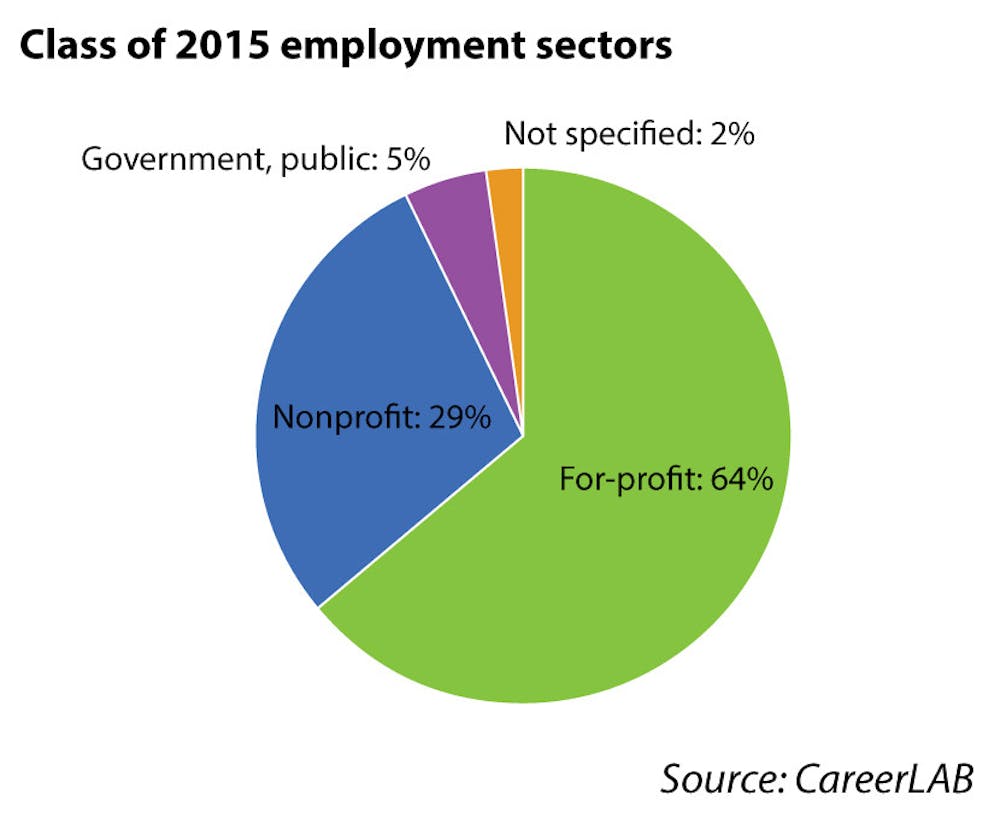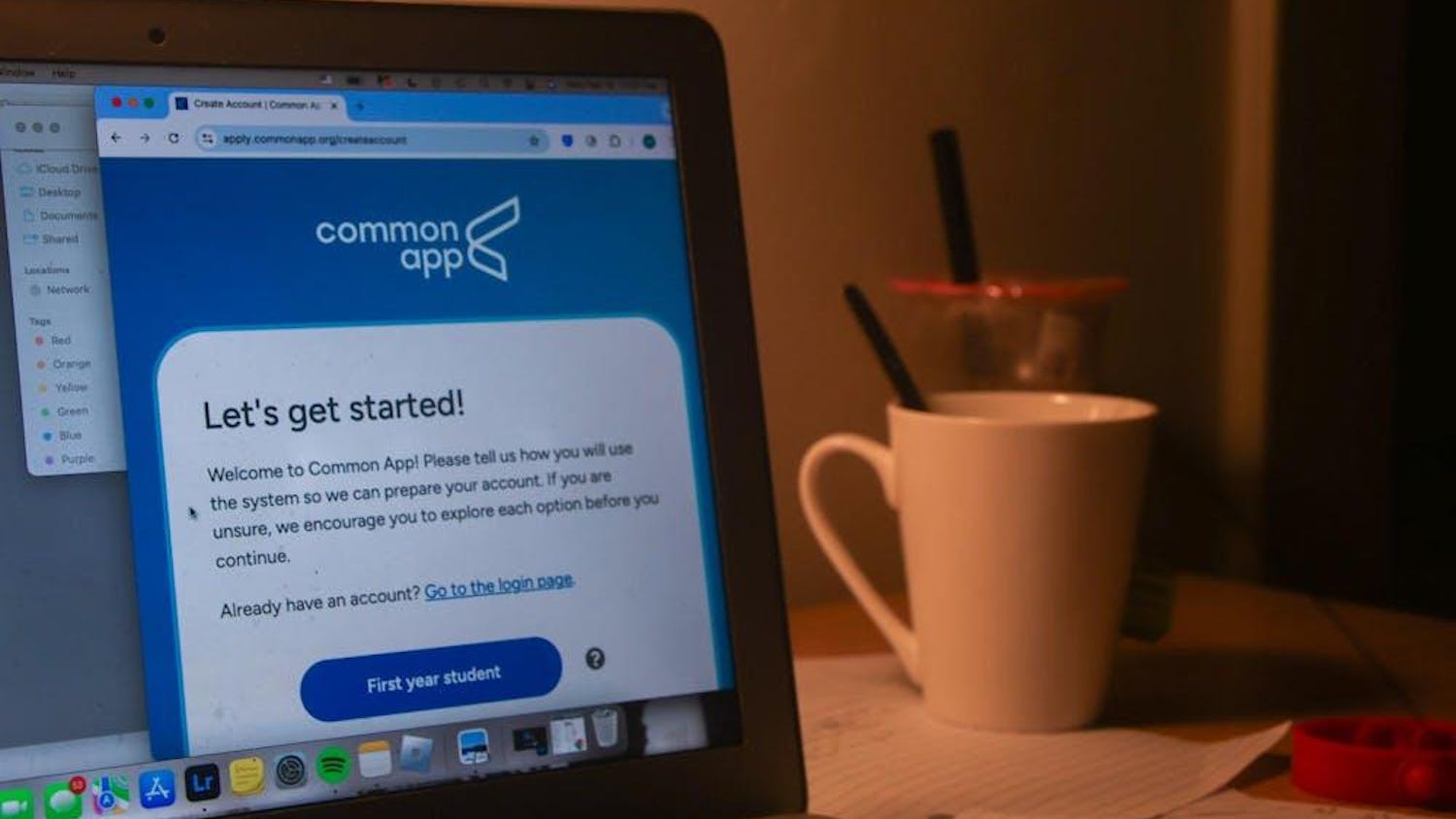Brown graduates enter the nonprofit sector at higher rates than graduates from peer institutions, according to data from the CareerLAB. Twenty-nine percent of 2015 graduates entering the workforce joined the nonprofit sector upon leaving Brown, and another 5 percent entered positions in government and public service.
According to 2013 data from the Office of Institutional Research, which conducts an alumni survey every five years, those percentages spike among graduates from certain concentrations: 39 percent of life and medical science and 33 percent of independent concentrators from the Class of 2003 held positions in the nonprofit sector. CareerLAB has found that the percentages of graduates in nonprofits hold steady over the years.
Just last month, Business Insider ranked Brown seventh in “The 25 best colleges for students who want to change the world,” highlighting the Swearer Center for Public Service and programs such as A Better World by Design as support systems and opportunities for students to involve themselves in public service work. No other Ivies appeared on the list.
Alums agreed that Brown’s campus atmosphere and academic opportunities are conducive to student interest in nonprofit work.
“The stereotype is right that there’s an attitude about wanting to save the world,” said Barrett Hazeltine, professor emeritus of engineering.
Socially conscious
As an undergraduate, Juan Carranza ’12 UEP’15 was unsure of how to relate his academic interests to a career. Upon graduation, he joined the College Advising Corps, an AmeriCorps program run in partnership with the Swearer Center. Through the program, he worked at Central High School in Providence for two years.
Currently, as a program manager for the Swearer Center, Carranza oversees BRYTE, Brown’s refugee tutoring program, and Health Leads in a partnership with LifeSpan, a healthcare system that is partnered with the Alpert Medical School.
While at Brown, Carranza was very involved with the Latinx community. “That work in and of itself wasn’t service-related, but the thread I saw throughout that was an aspect of mentorship,” he said.
In receiving guidance as an underclassman, then passing that advice on as an upperclassman, Carranza and other students “recognized the opportunity and privilege we were afforded by being here,” Carranza said. The feeling of obligation to share insight also emerged during his time in the Advising Corps, where he found his passion for education, he said.
Thea Aguiar ’13, who currently works for Bridgespan, a nonprofit consulting firm, felt that same pull toward service. Though she entered Brown with an interest in social inequality, her academic work across the social sciences and her business courses developed her ability to address those issues, she said.
“Brown nurtured and equipped me to have a career in the nonprofit sector. I think I always cared and was always interested in creating a positive impact on the world,” Aguiar said. “Brown helped affirm that.”
Her junior year, Aguiar worked on a global independent study project in India. That, combined with her work as a teaching assistant for Alan Harlam’s Social Entrepreneurship course and her work in the SEEED Summit, gave her a more concrete idea of how she could work in the nonprofit sector, Aguiar said. “The ethos of the Brown community has at the center of it a spark of contributing positively to the world around you,” she added.
The emphasis on social innovation in academics as well as co-curriculars allows students to apply their learning in an “actionable way,” said Matt Donato, director of CareerLAB.
Brown’s investment in social innovation and nonprofit work is not a new development. As a graduate student, Amy Kantrowitz MAT’92 worked in the Swearer Center on programs teaching English as a second language.
“Brown allows students to integrate what interests them in actual work with their studies,” Kantrowitz said. At other schools, student-run independent nonprofits are treated as extracurriculars rather than part of their core learning, she added.
The Swearer Center
Jim Amspacher, a career counselor at CareerLAB, similarly finds that the combination of public interest research groups, highly active student groups and the Swearer Center encourages students to pursue public service work in and around campus.
No peer institution has a center that is “as big or effective” as Swearer, Amspacher added.
Amspacher, who worked at the Public Interest Network for 18 years and interacted with 25 to 30 schools as a campus recruiter before coming to Brown, said, “Brown is just different.”
In his own work at PIN, “I don’t know if we changed the debate or got to the core of the problem. I see Brown students doing that,” Amspacher added.
Kantrowitz said that Brown’s “institutional investment in making this a core part of people’s education and a legitimate career path” contributes a great deal to the high student persistence in nonprofit work.
CareerLAB hosted a Careers in the Common Good Job fair mid-February, featuring 45 employers, Amspacher said. 400 students attended.
Though students have consistently demonstrated interest in building relationships with nonprofit programs and employers, it is “much more labor-intensive” to do so, Donato said. He added that smaller nonprofit organizations cannot always spare staff to go recruit on campuses, whereas large banks and consulting firms have systems in place and regular recruiting seasons.
It’s “really hard to go through that process without having those connections,” said Lauren Suiter ’15, who worked with the Center for New York City Neighborhoods through the CCG program the summer after her junior year and was hired there after graduation.
“There is no road map in nonprofit,” Donato said, adding that it is “unclear when nonprofit recruiters will be on campus, or if they’ve ever been to campus.”
University funding
Because many nonprofit internships are unpaid, CareerLAB provides resources for undergraduate students to interact with nonprofit employers and experience nonprofit work by offering subsidized internships.
Each summer, CareerLAB runs the Careers for the Common Good internship program in New York City. Though the program began with six positions, partly funded by CareerLAB and the employers, last year a donor came forward and funded 20 positions at $4,000 per participant for the next five years, Amspacher said.
The donation opened more doors for the program, as nonprofits may lack the funds to support large internship programs, Amspacher said.
“It’s really hard to find an internship that pays and is in a field that you wanted to work in,” Suiter said. “CCG gave me the opportunity to work for a nonprofit and get that experience and get paid.”
CareerLAB is working on expanding the program to Washington to begin in the summer of 2017.
Alongside CCG, CareerLAB offers Innovate Winter Break, a two-week internship experience over winter break at nonprofit and social entrepreneurship employers in New York, Boston, D.C. and San Francisco. CareerLAB also partners with the Swearer Center for iProv, a summer internship program in Providence that focuses on social justice work.
The opportunities provided through CareerLAB and the Swearer Center are unique to Brown, Kantrowitz said. This is “not just an internship program — it’s a real networking development,” she added.
The Swearer Center provides grants for some 200 students total, said Lizzie Pollock, assistant director of social entrepreneurship at the Swearer Center. The Swearer Center further offers funding to students to start their own social innovation ventures, she added.
The Social Innovation Fellowship provides students funding to work on a project full-time over the summer and offers year-round workshops, resources and mentoring, Pollock said. Currently in its eighth cohort, the fellowship supports 10 to 20 fellows each year.
The Swearer Center also recently launched the Embark Fellowship, which offers funding to students who want to work on their ventures full-time after Brown, moving social innovation beyond the campus sphere and into the real world, Pollock said.
“Usually the (students) who were able to do that had resources from their families. This is a way to level the playing field,” Pollock said.
Post-grad prospects
Upon considering post-graduation plans, financial concerns do play into students’ decisions to enter the nonprofit sector, Donato said.
When counseling students, Amspacher emphasizes the importance of taking financial feasibility into account, he said.
After receiving encouragement from a friend to apply for the Advising Corps position, Carranza did not have any hesitations about the program, but he did have questions — mostly about money.
“It’s an AmeriCorps job, so the stipend is not lucrative at all,” Carranza said. He notes that he was lucky because he was able to rely on his parents for some support.
In general, Carranza advises students to be very transparent about what is and is not feasible for them. After graduation, Carranza shared an apartment with two close friends who were also in AmeriCorps programs, and “that experience with two very good friends in the same boat — that made the difference,” he said.
Though Carranza had a personal connection with the AmeriCorps work, what graduates do immediately after Brown does not determine the rest of their career paths, he said.
Donato also noted that students’ first jobs after graduation are likely to change anyway, and it is “okay to fulfill your needs as long as you get to your passion” in the long run.
Financial concerns should ultimately not dissuade students from pursuing a job in the nonprofit sector, Pollock said. “There are a lot of jobs that don’t pay very well, but there are actually a lot that do.”
“I don’t think that doing well and doing good are mutually exclusive,” Pollock said.





